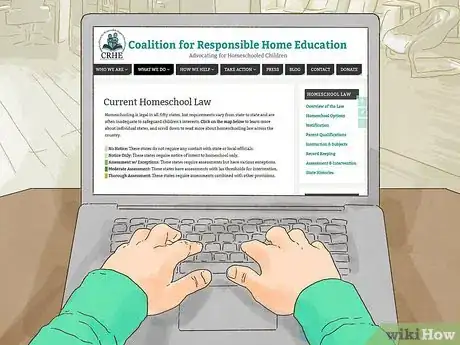This article was co-authored by Jake Adams. Jake Adams is an academic tutor and the owner of Simplifi EDU, a Santa Monica, California based online tutoring business offering learning resources and online tutors for academic subjects K-College, SAT & ACT prep, and college admissions applications. With over 14 years of professional tutoring experience, Jake is dedicated to providing his clients the very best online tutoring experience and access to a network of excellent undergraduate and graduate-level tutors from top colleges all over the nation. Jake holds a BS in International Business and Marketing from Pepperdine University.
There are 11 references cited in this article, which can be found at the bottom of the page.
This article has been viewed 24,961 times.
Public school isn’t the right fit for every child. Homeschooling provides the opportunity for children to experience a tailored education that flexibly fits their unique needs, schedule, and learning abilities. While this may be the perfect educational approach for your child, transitioning from public school requires preparation and commitment.
Steps
Preparing to Withdraw
-
1Check the legal requirements for homeschooling in your state. Every state has its own rules, and you’ll want to start your transition on the right legal foot. You can find an overview of current homeschool laws here: https://www.responsiblehomeschooling.org/policy-issues/current-policy/
- Twenty-four states currently require some periodic assessment of your child’s knowledge. This assessment usually follows one of two formats: standardized testing or a portfolio review.
- Standardized testing can be arranged either through local public schools or independently.[1]
- For a portfolio review, a certified teacher will examine and approve a collection of your child’s work, including writing samples, reading lists, math tests, and science labs. If your state relies on portfolio reviews, you’ll want to start saving examples of your child’s work as soon as you begin homeschooling.
-
2Make a budget for your homeschool. You’ll be responsible for school supplies, books, and any online curricular content you purchase. Create a list of these costs and incorporate them into your family’s financial planning.[2]Advertisement
-
3Notify your local school officials and teachers. While not all states require that you inform the school about your plan to withdraw, it’s a good idea to exit your public school with courtesy. Have an open conversation explaining why you want to switch, and ask for any advice administrators or teachers might be willing to share.[3]
- Especially if your child plans to continue participating in extracurricular activities, you’ll want to maintain a good relationship with the school community.
-
4Secure your child’s records. If your child has been in public school for several years, the district will have a file containing their medical and academic records. You’ll want to access these records to make sure they’re not lost when you withdraw your child, and so you are fully aware of your child’s educational experience up to this point.[4]
-
5Discuss the plan with your child. Be honest and clear about your plan to withdraw your child from public school, talk about their needs, and be sure to listen to what they have to say.
- Try asking your child questions about what they like and don’t like about school now, and what they would want to learn about if they could pick their own lessons. This will jumpstart a conversation that allows you both to talk about your expectations for homeschooling.[5]
- Give your child plenty of time to reflect on your conversation and their new reality. Introduce the topic well ahead of the date you plan to withdraw.
-
6Explore homeschooling options. There are many different teaching methods and curricula available for homeschooling. Reflect on your reasons for switching along with your child’s learning preferences, and develop your approach according to their unique needs.[6]
- Choosing your curriculum will largely depend on how your child best learns and how you best teach. You’ll want to decide whether to adhere to a more traditional, textbook-based curriculum, or to take the alternative route by designing and compiling a less structured curriculum.
- Some parents choose to participate in established online homeschools. The main benefit of these programs is that much of the content preparation is done for you.
-
7Read user reviews. Taking the time to research other parents’ experiences with various homeschooling materials and online schools is the best way to ensure that you’re purchasing high-quality content that works. Reviews will also usually specify the driving teaching philosophy of the curriculum.[7]
Establishing Your Homeschool
-
1Take time to adjust. Up to this point, your child will have spent a large majority of their time at a school that’s not your home. Give them a few weeks off from academic study so they can process their emotions regarding this shift.
- Some homeschooling parents recommend giving your child at least two weeks and up to a month of time off from school before beginning your homeschool curriculum.
- During this transition, you may want to incorporate hands-on lessons to maintain or renew your child’s enthusiasm for learning. You can explain the chemistry behind baking cookies or take a nature walk through the woods.[8]
-
2Establish a daily schedule. Pick hours that work for your family, and stick to that plan. Even though flexibility and spontaneity are hallmarks of successful homeschools, especially at the beginning of the transition, you’ll want to ensure that your child recognizes that their home is now also their school.
- To set up this schedule, reflect on which hours of the day your child has the hardest and easiest time learning. Schedule difficult subjects during their high-attention hours, and easier ones when they might need less brain power. Be sure not to block more than 45 minutes to an hour of any one subject.
- You don’t need to adhere to typical 8:00-3:00 public school hours, but your child may crave continuity as they move away from the public-school model and begin learning in a new environment.
-
3Add time for recreation. Public schools build in blocks of time for children to either play outside, rest, or study independently, allowing children time to recharge. Make sure that these “relaxed” blocks of time are part of your daily schedule so that your child’s school day contains both work and play.[9]
-
4Keep track of your child’s work. Even if your state doesn’t require that you be prepared for a portfolio review, it’s a good idea to keep orderly records of your child’s progress. This will help your child if they choose to apply to college, or they want to transition back to public school at a later date.
Helping Your Family Adjust
-
1Ask for feedback. This will be a learning process for you and your child. Make sure your child knows that you’re open to their ideas, comments, questions, and critiques. This will allow your child to feel invested in the transition and their new education.[10]
- Your child may initially ask you to replicate certain elements of their public school experience. While you made this transition for a reason, let your child guide the pace of the switch.
-
2Stay involved in the community. When your child leaves their public school, they may be most worried about leaving their friends behind. In order to ensure that you and your family are remaining socially connected, continue or expand your child’s involvement in extracurricular activities.[11]
- Many extracurricular activities are not directly connected to the public school system, including civic clubs such as the Girl or Boy Scouts. Sports teams may also be organized through the community, rather than the school. Be aware of your options, and be sure to budget for the extra costs of these activities.
-
3Set playdates. Even if your child isn’t a fan of extracurricular activities, they’ll surely miss their friends as they transition away from public school. Schedule periodic visits between your child and their closest friends. Make sure your child knows that they can rely on you to make these social activities a consistent part of their life.
-
4Build a support network. There will almost certainly be ups and downs over the course of this transition. Tell your extended family and friends about your plans, and get ready to rely on them when you need it. There are also many online and in-person support groups for homeschooling parents that you should look into joining.
- If a homeschool support group doesn’t yet exist in your area, consider starting one. There may be other parents who feel a similar need in your community, and they’ll be grateful for your efforts.
Community Q&A
Did you know you can get expert answers for this article?
Unlock expert answers by supporting wikiHow
-
QuestionWhat should I do if I'm transitioning from homeschooling back to a traditional school?
 Jake AdamsJake Adams is an academic tutor and the owner of Simplifi EDU, a Santa Monica, California based online tutoring business offering learning resources and online tutors for academic subjects K-College, SAT & ACT prep, and college admissions applications. With over 14 years of professional tutoring experience, Jake is dedicated to providing his clients the very best online tutoring experience and access to a network of excellent undergraduate and graduate-level tutors from top colleges all over the nation. Jake holds a BS in International Business and Marketing from Pepperdine University.
Jake AdamsJake Adams is an academic tutor and the owner of Simplifi EDU, a Santa Monica, California based online tutoring business offering learning resources and online tutors for academic subjects K-College, SAT & ACT prep, and college admissions applications. With over 14 years of professional tutoring experience, Jake is dedicated to providing his clients the very best online tutoring experience and access to a network of excellent undergraduate and graduate-level tutors from top colleges all over the nation. Jake holds a BS in International Business and Marketing from Pepperdine University.
Academic Tutor & Test Prep Specialist Contact the school where you're planning on sending your child and ask if they have something called a bridge program. These are small summer programs where your child takes a class or two with other students that are trying to get ahead or catch up. This may make things easier for your child as they prepare for the new environment!
Contact the school where you're planning on sending your child and ask if they have something called a bridge program. These are small summer programs where your child takes a class or two with other students that are trying to get ahead or catch up. This may make things easier for your child as they prepare for the new environment!
References
- ↑ https://www.responsiblehomeschooling.org/policy-issues/current-policy/
- ↑ http://www.huffingtonpost.com/entry/home-schooling-vs-public-schooling-making-the-right_us_57d277c3e4b0f831f7071a82
- ↑ http://www.greatschools.org/gk/articles/homeschooling-curriculum-online/
- ↑ http://www.confessionsofahomeschooler.com/blog/2014/10/homeschooling-101-switching-to-homeschool-mid-year.html
- ↑ https://www.todaysparent.com/family/how-to-talk-to-your-child-about-home-schooling/
- ↑ https://www.thehomeschoolmom.com/homeschool-help/getting-started-homeschooling/
- ↑ https://www.hslda.org/earlyyears/Curriculum.asp
- ↑ http://www.calverteducation.com/homeschooling/de-schooling-the-homeschooling-child
- ↑ http://lifeasmom.com/getting-started-in-homeschooling-creating-a-daily-schedule-or-routine/
- ↑ http://www.reallifeathome.com/how-to-transition-from-public-school-to-homeschool/
- ↑ Jake Adams. Academic Tutor & Test Prep Specialist. Expert Interview. 20 May 2020.

































































